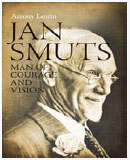Serviços Personalizados
Artigo
Indicadores
Links relacionados
-
 Citado por Google
Citado por Google -
 Similares em Google
Similares em Google
Compartilhar
South African Journal of Science
versão On-line ISSN 1996-7489
versão impressa ISSN 0038-2353
S. Afr. j. sci. vol.107 no.1-2 Pretoria Jan./Fev. 2011
http://dx.doi.org/10.4102/sajs.v107i1/2.530
BOOK REVIEWS
Chris Saunders
Department of Historical Studies, University of Cape Town, South Africa
Book Title: Jan Smuts Man of Courage and Vision
Book Cover:

Author: Anthony Lentin
ISBN: 978-1-86842-390-3
Publisher: Jonathan Ball Publishers, Johannesburg, 2010. p. 240; R165.00*
The anniversaries of the birth in 1870 and death in 1950 of Jan Smuts passed unnoticed in the South Africa of 2010, but the publication of this book reminds us how remarkable a man he was. There are of course many biographies of him, with that by the Australian historian Sir Keith Hancock in two volumes remaining the best. This is not another general biography, despite the title, but instead a study that focuses on Smuts' role at the Paris Peace Conference of 1919. That role has not been given as detailed a treatment as it deserves. When some years ago Margaret MacMillan, now the Warden of St. Antony's College, Oxford, published a prize-winning book on the conference entitled Peacemakers: The Paris Conference of 1919 and Its Attempt to End War (2002) she did not accord much attention to Smuts, other than as the writer of 'dazzling analyses' for his British colleagues at the conference and as the drafter of the proposal for a League of Nations that was taken over by President Woodrow Wilson. Introducing Smuts to her readers, MacMillan wrote that he 'was not particularly imposing at first glance' and mentioned how in London a British official 'thought he had come to fix the electric light and curtly told him to wait outside'.
The very brief book under review - little more than 150 pages of text - belongs to a series on the leading participants of the Paris Conference, although Lentin does provide some background on Smuts before he went to Paris, and he adds three short chapters on the legacy of the conference, in which he considers Smuts' activities during and after the Second World War. Lentin has written on the Paris conference before, but makes no reference to MacMillan's book in his discussion of the relevant literature, perhaps because he wishes to place much more weight than she did on the role that Smuts, whom he clearly admires greatly, played at the Paris conference. Of all those at the conference, he writes, Smuts was 'from first to last in my judgment the most principled, level-headed and far-sighted'. Lentin agrees with Smuts' view at the time that the conference was a tragic failure. Though Smuts very reluctantly joined his South African colleague Louis Botha, the Prime Minister, in signing the Treaty of Versailles at the end of the conference, he called the treaty an 'abomination'. Much influenced by the British magnanimity that saw self-government returned to the former Boer republics only four years after the Treaty of Vereeniging, Smuts believed that the Paris conference should have emphasised reconciliation and moderation instead of imposing a `Carthaginian peace' on Germany, thereby laying the seeds for the Second World War. As this review was written in October 2010 the astonishing fact was reported that Germany had finally made the final payment on the reparations imposed on it for the First World War...
There is no doubt that Smuts did play a significant role at the Paris conference, even though he was, as he put it, a 'representative of one of the smallest and least of the states', and not even South Africa's chief representative, though Botha was ill for much of the time. Even if it is true that he had on one occasion been mistaken for the man to fix the electric light, Smuts had been a member of the Imperial War Cabinet and become one of the most trusted advisers of the leading British politicians of the day. Lentin, a former professor of history at the Open University and now based at Wolfson College, Cambridge, clearly knows the British background very well, but appears to know relatively little of South Africa. He makes no mention of the recent writing on Smuts by Saul Dubow and Shula Marks and makes a number of small slips, such as saying that there is a Jan Smuts House and a Smuts Chair of International Relations at the University of Cape Town: while Smuts Hall is one of the University of Cape Town's oldest residences, only the University of the Witwatersrand has a house and chair named after Smuts. Smuts' defeat in the 1948 election was not 'assisted by the Germans of South-West Africa', for the White people of that territory were given the vote only the following year. Lentin makes no reference to the presence at Versailles of a delegation sent by the South African Native National Congress (which was to change its name to African National Congress in 1923), which lobbied in vain against the 1913 Land Act and other discriminatory legislation of the new Union government. This readable but short and largely uncritical book has the merit of emphasising Smuts' wisdom and far-sightedness in relation to the international concerns of his day. While his failures at home, above all his support for racial segregation, have tarnished his reputation, it should not be forgotten that he played a role on the international stage rivalled only by that of Nelson Mandela in our own time.
 Postal address:
Postal address:
Department of Historical Studies, University of Cape Town
Rondebosch 7701
South Africa
email: chris.saunders@uct.ac.za
* Book price at time of review














